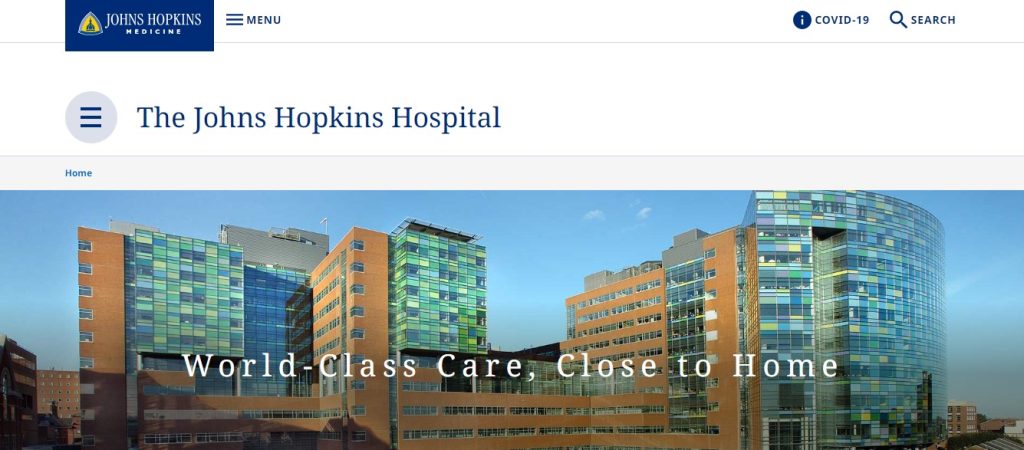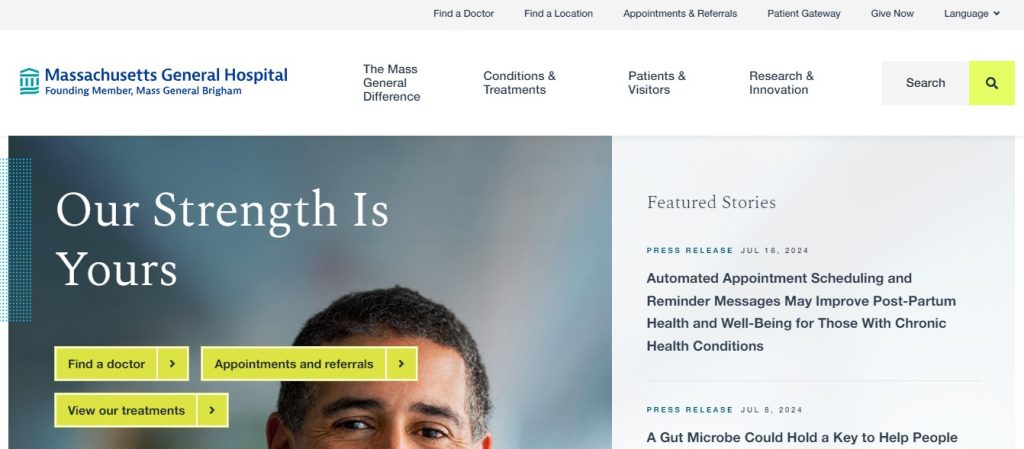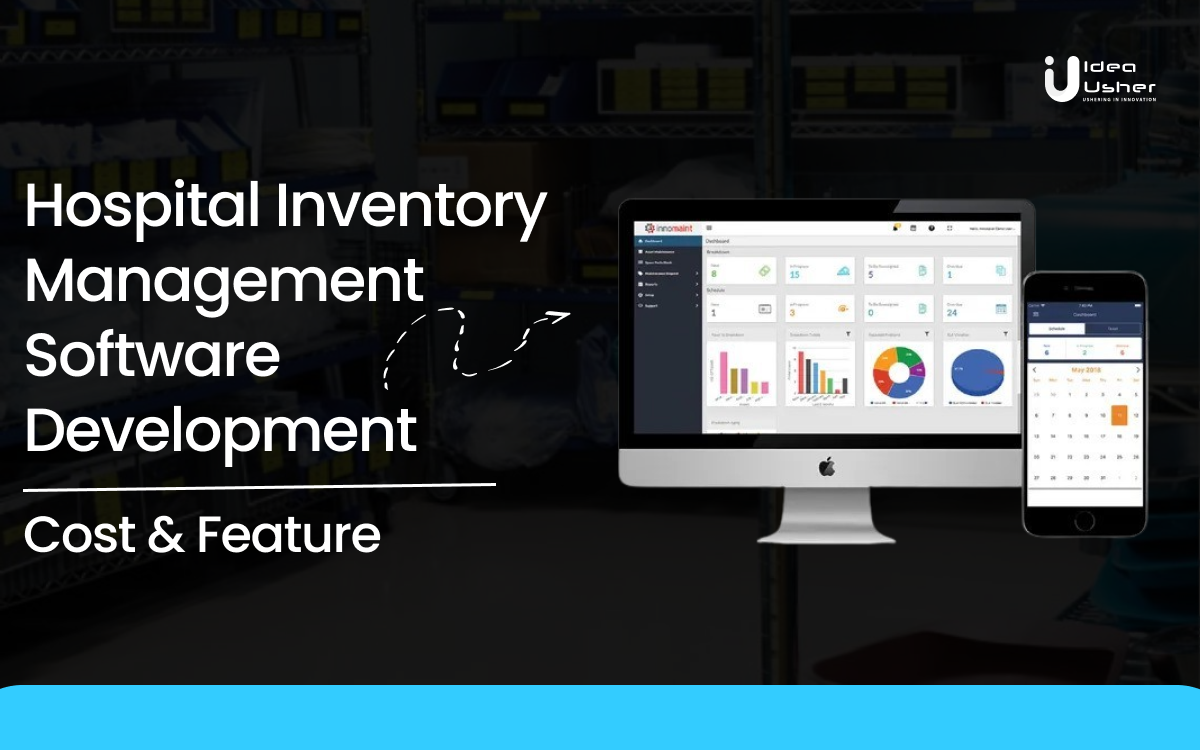Hospitals are the places that cannot afford to suffer, at least due to stockouts, wastage, errors, inefficiencies, manual work, and operation costs. Managing all these things is important and equally challenging at times.
To address all those concerns, hospital inventory management software was introduced. It helps with basic manual tasks, complex operations, supplies management, patient safety, and regulatory compliance while allowing data-driven decision-making in healthcare facilities. This software plays an important role in maintaining a well-organized, cost-effective, and efficient healthcare environment. Notably, the healthcare inventory management systems market is anticipated to reach $38.47 billion by 2029, growing at a 5.5% CAGR, which indicates the promising future of these solutions.
In this blog, we will explore the costs, key features, and development process of hospital inventory management software. We will also analyze its impact on improving hospital efficiency and the significant market potential it holds for you!
Hospital Inventory Management System: Overview
A Hospital Inventory Management System, or HIMS, is a software tool designed to manage medical supplies, equipment, and pharmaceuticals efficiently. It helps healthcare facilities keep track of inventory, streamline processes, and cut costs.
HIMS provides real-time updates on stock levels, which makes it easy to monitor available resources. It automates ordering to avoid running out of essential items and helps manage incoming shipments effectively. Plus, proper stock rotation through HIMS reduces waste by ensuring older items are used first. Additionally, its integration with EHRs and other systems also enhances its functionality and makes it capable of supporting accurate data management and regulatory compliance.
Who Uses It?
This software is mostly used by hospital administrators, procurement managers, supply chain teams, and pharmacy staff. Clinical staff also interact with the system to request supplies or check stock levels. Additionally, finance departments use the data from the system for budgeting and cost control.
Key Features Of Hospital Inventory Management System
Here are some of the key features of HIMS software:
- Barcode and RFID Integration: Incorporates barcode and RFID technology for precise tracking and management of inventory items.
- Custom Alerts: Sends real-time notifications for low stock, upcoming expirations, and other critical events to avoid disruptions.
- User Role Management: Assigns specific access levels based on roles, ensuring secure and efficient operations across the hospital.
- Expiry Management: Keeps track of expiration dates to avoid the use of expired items.
- System Integration: Integrates seamlessly with EHRs, ERP systems, and other hospital management software for cohesive operations.
- Real-time Stock Monitoring: Continuously tracks the availability of drugs, medical supplies, and equipment to make sure that items are always in stock.
- Automated Replenishment: Automatically triggers reorder processes when inventory levels fall below preset thresholds.
- Advanced Reporting & Analytics: Provides detailed insights and metrics on inventory usage, trends, and costs to support better decision-making.
- Security & Compliance: Ensures that all data is secure and compliant with healthcare regulations while protecting sensitive information.
How Does The Hospital Inventory Management System Work?
A hospital inventory management system operates through a streamlined process that ensures efficient management of medical supplies and equipment:
- Inventory Setup: Items are cataloged with details like name, description, unit measurement, and storage location. It also stores the supplier data, including pricing and contracts.
- Inventory Tracking: Items are tagged with barcodes or RFID for precise tracking. The system uses real-time scanning to monitor the flow of inventory throughout the hospital.
- Automated Reordering: Par levels are established for each item. When stock dips below these levels, the system automatically generates purchase orders and selects suppliers based on criteria such as cost and delivery efficiency.
- Receiving and Storage: Incoming items are verified against purchase orders and stored in designated locations. The system enforces ‘First In, First Out’ to reduce waste and tracks expiration dates.
- Usage Monitoring: The system records the consumption of items, tracking who used what and where while identifying waste reduction opportunities.
- Reporting and Integration: The system generates reports on inventory levels, usage, and costs and integrates with EHR and LIS to align with patient care activities and lab operations.
Market Takeaways For Hospital Inventory Management Software
In 2023, the market for Healthcare Inventory Management Software was valued at $22.1 billion. Looking ahead, it is set to experience a growth rate of 5.4% annually through 2030.

At the same time, the Hospital Asset Tracking and Inventory Management Systems Market is on track to increase from $29.43 billion in 2024 to $38.47 billion by 2029. This growth reflects an annual rate of 5.5% during this period. This upward trend underscores the rising need for sophisticated inventory management solutions in the healthcare sector.
Benefits Of Healthcare Inventory Management Software
Healthcare inventory management software offers numerous advantages that improve operational efficiency and financial performance.
- Increased Efficiency: Automates routine tasks such as order management, expiration tracking, and report generation. This leads to streamlined workflows and allows staff to focus on patient care.
- Cost Savings: Optimizes inventory levels and reduces wastage, which minimizes the need for costly emergency purchases. This results in significant cost reductions and improved financial health.
- Enhanced Decision-Making: Provides detailed analytics and reporting, enabling informed decisions and strategic planning. This data helps adjust inventory practices and improve resource allocation.
- Regulatory Compliance: Maintains accurate records and adheres to healthcare standards, minimizing the risk of compliance issues and penalties.
- Improved Market Position: Boosts the efficiency and reliability of healthcare services, enhancing the facility’s reputation and providing a competitive advantage.
- Revenue Growth: Ensures optimal stock levels and reduces waste, contributing to cost savings and increased profitability. Efficient service delivery can attract more patients and boost revenue.
- Predictive Capabilities: Uses advanced analytics to forecast demand and adjust inventory accordingly, identifying revenue opportunities and optimizing resource usage.
Must-have Features For A Hospital Inventory Management Software
Healthcare inventory management software is widely favored for its range of features designed to improve efficiency and accuracy in managing medical assets. Some of the most appreciated features are:
1. Barcode And QR Code Scanning
This feature enables precise tracking of assets. Scanning barcodes or QR codes ensures that inventory management is both accurate and efficient, reducing manual entry errors. Mayo Clinic utilizes barcode scanning to track medical equipment and supplies precisely and ensure accurate asset management. Another example is Cleveland Clinic, which uses QR codes and barcode scanning to maintain and manage inventory across various applications.
2. Automated Reordering
The software automatically generates purchase orders when inventory levels dip below established thresholds. This ensures that stock is replenished promptly, preventing shortages and disruptions. Johns Hopkins Medicine is a prominent name that relies on automated reordering systems to keep inventory levels steady while reducing the risk of shortages and overstocking. Stanford Health Care similarly employs these systems to streamline its supply chain while improving the availability of critical supplies and optimizing inventory management.
3. Expiry Date Tracking
Effective management of expiration dates prevents the use of outdated supplies. This feature helps in maintaining the safety and effectiveness of medical items, thereby reducing waste. In the real-world, Massachusetts General Hospital and Parkland Health implement these features to monitor the expiration dates of medical supplies and to keep track of supply lifespans, which helps them prevent the use of expired products and maintain high-quality standards.
4. Real-Time Inventory Monitoring
Offers live visibility into current inventory levels, helping to prevent both stockouts and overstock situations. This real-time data supports better inventory control and decision-making. Kaiser Permanente is one of the well-established healthcare organizations that use real-time inventory monitoring to manage and track supplies. Cedars-Sinai Medical Center also utilizes the benefit of this feature to maintain adequate stock levels and prevent shortages.
5. Advanced Reporting And Analytics
This feature provides in-depth insights into inventory usage patterns and trends. These analytics help users make informed decisions based on comprehensive data. Intermountain Healthcare uses this feature to refine its inventory management practices and make data-driven decisions. Apart from this, Henry Ford Health System also applies these analytics to understand inventory usage patterns, which helps them with better management and optimization of resources.
6. System Integration
This is basically the integration of healthcare inventory management systems with other healthcare systems, such as EHRs and ERP, which creates a cohesive management environment. Memorial Sloan Kettering Cancer Center and UCSF Health are the popular names. They have integrated their inventory system with other healthcare platforms to create an integrated environment that enhances overall efficiency and functionality.
7. Mobile Accessibility And User-Friendly Design
You can allow inventory management from mobile devices to offer flexibility and convenience for staff to manage inventory tasks remotely. You can feature an intuitive interface that simplifies the process for all users and makes sure that the system is easy to navigate and operate. In the real-world, Children’s Hospital of Philadelphia and Mount Sinai Health System are well-established organizations that provide mobile access to its inventory tools and improve convenience and operational effectiveness.
8. Predictive Analytics
Employs artificial intelligence and machine learning to forecast future inventory needs. This predictive capability helps optimize stock levels and plan for demand fluctuations. Partners HealthCare and Northwestern Medicine utilize these advanced analytics features to forecast inventory requirements, which improves their supply chain efficiency and stock levels.
Architecture Of A Hospital Inventory Management System
A hospital inventory management system is structured to enhance the oversight and administration of medical supplies and equipment. Its architecture is designed to ensure precise inventory tracking, timely availability of resources, and overall operational effectiveness.
1. RFID Technology
RFID tags are attached to medical items and equipment, holding critical data. These tags interact with RFID readers to provide continuous, real-time information on the location and status of inventory. This technology supports accurate tracking and minimizes manual handling errors.
2. RFID Readers
RFID readers are installed at strategic locations within the hospital. They capture data from RFID tags, updating the inventory system in real-time. This setup ensures that the movement and usage of medical supplies are accurately monitored, facilitating better stock management.
3. Integration With Electronic Health Records
Integration with EHR systems links patient records directly with inventory data. This connection ensures that necessary supplies and medications are available based on patient treatments and usage trends. It also helps forecast future inventory needs based on historical data.
4. Mobile Access
A mobile application for inventory management allows staff to monitor and manage inventory from anywhere within the hospital. This feature offers real-time updates, facilitates quick ordering, and helps locate items efficiently, improving workflow and responsiveness.
5. Third-Party System Integration
The system integrates with external suppliers, logistics partners, and financial software. This integration streamlines order fulfillment, supply chain coordination, and financial transactions, contributing to smoother operations and accurate reporting.
Development Steps For Hospital Inventory Management Software
Developing hospital inventory management software requires specific developmental steps:
1. Analyze Healthcare Operations
Start by thoroughly analyzing healthcare operations to identify the specific needs and regulatory requirements that the software must meet. This includes understanding the workflows related to patient care, surgical procedures, and supply chain management within hospitals. The analysis should also focus on ensuring compliance with HIPAA, FDA, and other relevant healthcare regulations. Use this understanding to guide the design of a system that can efficiently manage critical supplies, especially during emergencies.
2. Implement Data Security And Privacy Measures
The next step involves integrating strong data security and privacy measures into the software. This includes developing encryption protocols to protect sensitive patient data and implementing access controls that restrict data access based on user roles. Regular security audits should be scheduled to identify and resolve any vulnerabilities for the ongoing protection of healthcare information.
3. Develop Real-Time Inventory Tracking Capabilities
Focus on building a real-time inventory tracking system using technologies like barcodes or RFID. This system should be capable of monitoring items throughout the hospital’s supply chain, with features for automated replenishment based on inventory levels and usage patterns. Additionally, incorporate mechanisms to track the expiration dates of perishable items to prevent waste and maintain patient safety.
4. Integrate With Existing Hospital Systems
The software should be integrated with existing hospital systems to ensure seamless operation. This includes connecting with Electronic Health Records systems to provide real-time data on inventory usage and costs. Integration with Laboratory Information Systems and pharmacy systems is also essential to managing reagent supplies and medication inventory effectively. These integrations support a cohesive and efficient workflow within the hospital.
5. Develop Emergency Preparedness Features
Incorporate features that support emergency preparedness into the software. This involves creating tools for developing contingency plans for various disaster scenarios, such as natural disasters, equipment failures, and supply shortages. The software should also include real-time monitoring of critical supplies and algorithms to allocate resources efficiently during emergencies based on patient needs.
6. Build Cost Control And Optimization Functions
Develop functions within the software that focus on cost control and optimization. This includes tracking item usage to identify opportunities for cost reduction, such as minimizing waste or negotiating better supplier contracts. Implement features that enable bulk purchasing and price comparison to secure the most cost-effective options. Additionally, strategies like just-in-time inventory management can be included to further reduce waste.
7. Compliance With Medical Waste Disposal Regulations
Design the software to manage medical waste disposal in compliance with local, state, and federal regulations. This includes developing features to track the generation, storage, and disposal of medical waste. The software should stay updated with regulatory changes and generate the necessary documentation to meet compliance requirements. Integrating with waste management services can streamline this process and ensure proper disposal.
8. Integrate Supply Chain Management Systems
The final step involves integrating the software with supply chain management systems to streamline procurement and inventory processes. This includes developing features to store and manage supplier information, create and track purchase orders, and automate replenishment orders. Additionally, build tools to track the delivery of supplies and evaluate vendor performance so that the hospital can maintain reliable and efficient supply chains.
Tech Stack For Healthcare Inventory Management Software Development
Here is the required tech stack required for the development of hospital inventory management software development:
| Category | Technologies | Description |
| Web and Mobile Solutions | React, Angular, Vue.js (Web); React Native, Flutter (Mobile) | Frameworks and libraries for building responsive web and mobile applications. |
| Backend | Node.js, Django, Ruby on Rails | Server-side technologies for handling business logic and APIs. |
| Database Management | PostgreSQL, MySQL (SQL); MongoDB (NoSQL) | Databases for storing and managing structured and unstructured data. |
| Real-Time Tracking | RFID Technology, Barcode Scanning, IoT | Technologies for real-time tracking and automation of inventory. |
| Cloud-Based Solutions | AWS, Google Cloud, Microsoft Azure | Cloud platforms for scalable and flexible infrastructure. |
| Data Storage | Cloud-based storage solutions | Secure and accessible storage for data management. |
| AI and ML | AI/ML Models for predictive analytics | Models for forecasting inventory needs and optimizing stock levels. |
| Security and Compliance | SSL/TLS Encryption, HIPAA Compliance | Security measures and compliance with healthcare regulations. |
| Integration | RESTful APIs for integration with EHR and other systems | APIs for seamless integration with existing hospital systems. |
| Mobile Compatibility | Mobile Apps for on-the-go access | Mobile applications for accessing and managing inventory information remotely. |
| BI and Reporting | Tableau, Power BI | Tools for data visualization and generating reports. |
| UI/UX Design | Figma, Adobe XD | Tools for designing intuitive and user-friendly interfaces. |
Technologies Used in Inventory Management Software Development
Inventory management software uses several key technologies to help hospitals track and manage their stock effectively, like:
1. Barcode Scanning And RFID
Barcode scanning and Radio Frequency Identification help with inventory tracking. Barcode scanners read the codes on products and help in entering information quickly and accurately. RFID technology uses radio waves to identify and monitor items and provides real-time updates on their location and status.
2. Warehouse Management Systems
WMS handles tasks such as tracking stock, managing storage space, picking orders, and packing goods. Real-time updates from WMS help hospitals make better decisions about restocking and order fulfillment.
3. Supply Chain Management Integration
SCM software connects with inventory systems to better manage the entire supply chain. This integration helps with tasks like purchasing, production, and shipping. This makes sure inventory levels are closely aligned with demand and helps minimize delays.
4. Demand Forecasting Tools
Demand forecasting tools analyze past sales data to predict future inventory needs. These tools help hospitals adjust their stock levels to prevent shortages or excess inventory.
5. Inventory Optimization Software
Inventory optimization software helps determine the best stock levels. It considers factors such as delivery times and storage costs to suggest how much inventory to keep. This helps reduce costs and avoid stock problems.
6. Lot And Batch Tracking
These systems provide detailed records for each batch, which simplifies the process of tracing the product’s history. This functionality helps resolve quality issues and maintain compliance with safety regulations.
7. Point of Sale System Integration
Integrating inventory management with POS systems keeps inventory levels updated automatically with each sale. This connection helps track stock in real-time and supports efficient management of inventory across various sales channels.
8. Cloud Computing
Cloud computing allows access to inventory management systems and data from any location. Cloud-based systems offer real-time information on stock levels and help manage orders efficiently.
9. Mobile Technology And IoT
Mobile apps let staff update inventory information on the go, and IoT devices, like smart sensors, monitor conditions such as temperature and humidity to keep sensitive products in good condition.
Top Revenue Generating Methods For Inventory Management Software
To maximize revenue from your inventory management software, consider these effective strategies:
- Subscription Models: Offer a subscription-based pricing structure where customers pay a regular fee to use the software. Providing various plans with different features and support levels can cater to diverse needs and ensure a steady revenue stream.
- Usage-Based Pricing: Implement a usage-based pricing model where charges depend on how much the software is used. This could be based on the number of transactions, amount of data, or number of users. This approach aligns costs with actual usage, making it flexible for different healthcare institution sizes.
- Perpetual Licensing: Consider a one-time fee for perpetual licensing, which gives customers indefinite access to the software. This option is appealing to those who prefer a single payment over recurring fees. You can also offer additional features, such as support or updates, for an extra charge.
- Integration Services: Provide integration services to connect your software with other systems like ERP or electronic health records. Customizing these integrations can enhance the software’s value and generate additional revenue through setup and customization fees.
- Consulting Services: Offer consulting services to help clients improve their inventory management processes. Services such as audits, strategy development, and personalized recommendations add value to your software and create another revenue stream.
- Data Analytics and Reporting: Introduce advanced data analytics and reporting features as premium options. These features can offer valuable insights into inventory data. Charging for these advanced capabilities can increase your revenue.
- Target Marketing: Focus your marketing efforts on specific hospitals or departments that are most likely to benefit from your software. Targeted marketing can help attract the right customers and improve sales effectiveness.
- Sales Channels: Utilize multiple sales channels, including direct sales, partnerships, and online marketing, to reach a wider audience. This multi-channel approach can boost your market presence and lead to higher sales.
- Customer Success: Invest in providing excellent customer support and training. Ensuring that your clients are satisfied and well-supported can enhance retention rates and contribute to ongoing revenue.
Cost Of Developing A Healthcare Inventory Management Software
Here is a detailed breakdown of the financial investment you may have to put in. However, these are roughly estimated costs and can vary depending on the complexity of your project. It is best to get free advice from top-rated experts of reputed app development companies:
| Category | Technologies/Features | Minimum Cost | Maximum Cost |
| Research and Planning | Market Research, Requirement Analysis, Project Management | 500 | 3,000 |
| Frontend Development | UI/UX Design, Frontend Development | 500 | 12,000 |
| Backend Development | Server-Side Logic, Database Management, API Development | 1,000 | 20,000 |
| App Features | Real-Time Tracking (RFID, Barcode), Inventory Management, Integration with EHR, Reporting and Analytics | 1,500 | 15,000 |
| Advanced Technologies | AI/ML for Predictive Analytics, IoT Integration | 2,000 | 15,000 |
| Security and Compliance | Data Encryption, HIPAA Compliance | 1,000 | 3,000 |
| Testing and Quality Assurance | Manual Testing, Automated Testing | 500 | 1,000 |
| Deployment and Maintenance | Deployment, Maintenance and Updates | 500 | 1,000 |
| Additional Features | Automated Reordering, Demand Forecasting, Inventory Optimization, Maintenance Tracking, Low Stock Alerts, Detailed Reporting and Analytics, Mobile Access, Integration with Other Systems | 2,500 | 30,000 |
| Total Cost Range | – | $10,000 | $100,000 |
Cost-Affecting Factors To Consider For Healthcare Inventory Management Software
Here are some factors that highly influence the budget:
1. Adhering To Healthcare Regulations
Healthcare inventory management software needs to meet strict regulations like HIPAA to protect patient data. This requirement can lead to higher development costs and longer timelines due to the need for strong security features and careful data handling.
2. Integration With EHR
This is an important part that holds the potential to create a revenue stream. This process allows inventory systems to work well with patient records. However, achieving this integration requires specialized skills and can be costly and complex.
3. Real-Time Tracking And Monitoring
Real-time tracking using technologies like RFID and barcode scanning is important for timely stock management but involves significant expenses for installation and maintenance.
4. Advanced Security Measures
Securing sensitive medical data with advanced methods such as encryption and access controls helps prevent data breaches and unauthorized access but increases overall costs.
5. Utilizing Predictive Analytics And AI
Advanced features like predictive analytics and AI can forecast inventory needs and improve stock management, but they require a substantial investment in development and data analysis.
6. Providing User Training And Support
Investing in training and ongoing support helps users operate the system well but adds to the overall expense of the software.
Top 5 Leading Hospitals Using Healthcare Inventory Management Software
Here are the top five healthcare organizations utilizing inventory management software:
1. Mayo Clinic

Mayo Clinic upgraded its inventory system with Supply Plus between 2016 and 2018. This new software improved how they track and manage medical supplies, leading to better patient care and more efficient hospital operations.
2. Cleveland Clinic

In 2010, Cleveland Clinic introduced RFID technology to update its inventory system. This change moved them from old manual methods to automated processes, improving how they manage inventory and integrating smoothly with their electronic health records (EHR).
3. Johns Hopkins Hospital

Since the early 2000s, Johns Hopkins Hospital has used SAP software to enhance its inventory management. This system provides real-time tracking and automation, ensuring that critical supplies are available when needed across their hospitals.
4. Massachusetts General Hospital

Starting in October 2000, Massachusetts General Hospital began using AI and predictive analytics for inventory management. This technology helps forecast demand and optimize stock levels, especially in their radiology department, addressing past inventory challenges.
5. UCLA Health

UCLA Health has incorporated IoT and RFID technologies into its inventory management system to automate and monitor inventory processes. This technological integration has improved operational efficiency and minimized waste, showcasing UCLA Health’s commitment to leveraging modern solutions to enhance its inventory management practices.
Conclusion
Creating a hospital inventory management software is a significant step forward for healthcare facilities. The task of managing medical supplies can be complex and overwhelming, but custom software can make this process much simpler and more efficient. Such software can help you make sure that essential supplies are consistently available, which directly supports better patient care. Plus, an effective inventory management system has the potential to improve the accuracy of supply tracking and overall operational efficiency. Therefore, with the adoption of these processes, you can focus more on providing high-quality care. Ultimately, implementing a well-designed inventory management solution is a key factor in advancing healthcare services and improving patient outcomes.
Looking To Develop A Healthcare Inventory Management Software?
We are here to help. We have over 10 years of experience and 50,000+ hours of coding across 200+ projects. We’ve built several custom service apps that streamline operations and boost efficiency. Our team knows how to create software that fits your needs and helps your healthcare facility run smoothly. With our expertise, you can trust us to deliver a reliable and effective solution. Let’s work together to build a solution that supports your healthcare facility’s growth and improves your operations with a system designed just for you.
Work with Ex-MAANG developers to build next-gen apps schedule your consultation now
FAQ
Which programming language is best for inventory management?
Python is a good choice for inventory management due to its simplicity and useful libraries. JavaScript works well for web applications. For larger systems, Java or C# can be effective, providing strong features and reliability.
What is the inventory management process in healthcare?
In healthcare, inventory management involves tracking and managing medical supplies, medicines, and equipment. This process includes ordering, receiving, checking stock levels, and managing expiry dates. Proper management helps prevent shortages and waste, ensuring that essential items are always available.
What is the inventory management workflow?
Inventory management workflow is the series of steps to handle inventory from start to finish. It includes ordering, receiving, storing, tracking, and distributing items. This workflow ensures that stock levels are maintained, orders are accurate, and inventory records are kept up-to-date.
What is Kanban in inventory management?
Kanban is a method that uses visual signals, like cards or boards, to manage inventory. It helps track stock levels and shows when to reorder. Kanban improves the flow of materials, reduces excess inventory, and keeps operations running smoothly.




















